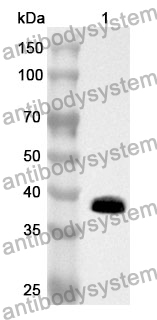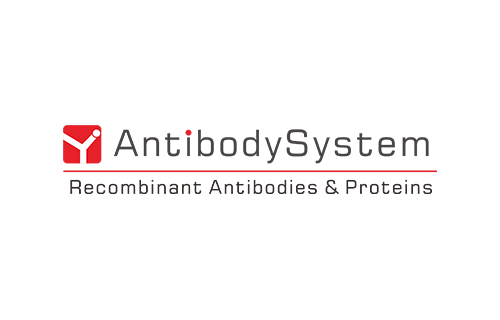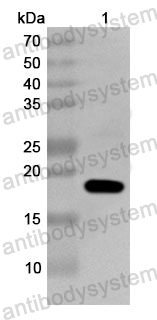Catalog No.
PHF69101
Species reactivity
Human, Mouse, Rat
Host species
Rabbit
Isotype
IgG
Clonality
Polyclonal
Immunogen
E. coli - derived recombinant Human ARG2 (Val23-Ile354).
Tested applications
ELISA: 1:4000-1:8000, IHC: 1:50-1:100, WB: 1:1000-1:4000
Target
Arginase-2,mitochondrial,Type II arginase,Kidney-type arginase,Arginase II,Non-hepatic arginase,ARG2
Purification
Purified by antigen affinity column.
Accession
P78540
Applications
ELISA, IHC, WB
Form
Liquid
Storage buffer
0.01M PBS, pH 7.4, 50% Glycerol, 0.05% Proclin 300.
Stability and Storage
Use a manual defrost freezer and avoid repeated freeze thaw cycles. Store at 2 to 8°C for frequent use. Store at -20 to -80°C for twelve months from the date of receipt.
Exploration of the Shared Gene Signatures and Molecular Mechanisms between Chronic Bronchitis and Antineutrophil Cytoplasmic Antibody-associated Glomerulonephritis: Evidence from Transcriptome Data., PMID:38847168
Antagonism of regulatory ISGs enhances the anti-melanoma efficacy of STING agonists., PMID:38312842
Age-related secretion of grancalcin by macrophages induces skeletal stem/progenitor cell senescence during fracture healing., PMID:38267422
Identification of potential molecular targets for the treatment of cluster 1 human pheochromocytoma and paraganglioma via comprehensive proteomic characterization., PMID:37749499
Characterisation of Expression the Arginine Pathway Enzymes in Childhood Brain Tumours to Determine Susceptibility to Therapeutic Arginine Depletion., PMID:35782058
Hypoxic pulmonary endothelial cells release epidermal growth factor leading to vascular smooth muscle cell arginase-2 expression and proliferation., PMID:35674115
Arginase is involved in cervical lesions progression and severity., PMID:35220072
EASINESS: E. coli Assisted Speedy affINity-maturation Evolution SyStem., PMID:34925322
A Novel Oral Arginase 1/2 Inhibitor Enhances the Antitumor Effect of PD-1 Inhibition in Murine Experimental Gliomas by Altering the Immunosuppressive Environment., PMID:34504786
TNFα induces endothelial dysfunction in rheumatoid arthritis via LOX-1 and arginase 2: reversal by monoclonal TNFα antibodies., PMID:33483748
A thermosensitive, reactive oxygen species-responsive, MR409-encapsulated hydrogel ameliorates disc degeneration in rats by inhibiting the secretory autophagy pathway., PMID:33391467
Structural and functional characterization of C0021158, a high-affinity monoclonal antibody that inhibits Arginase 2 function via a novel non-competitive mechanism of action., PMID:32880207
Extensive sequence and structural evolution of Arginase 2 inhibitory antibodies enabled by an unbiased approach to affinity maturation., PMID:32616569
Skin wound healing in gilthead seabream (Sparus aurata L.) fed diets supplemented with arginine., PMID:32544556
Nanostructured recombinant protein particles raise specific antibodies against the nodavirus NNV coat protein in sole., PMID:32105827
Arginase enzymes in the human prostate: A molecular biological and immunohistochemical approach., PMID:31482616
Hypoxic-induction of arginase II requires EGF-mediated EGFR activation in human pulmonary microvascular endothelial cells., PMID:29845760
Distribution of mannose receptor in blunt snout bream (Megalobrama amblycephala) during the embryonic development and its immune response to the challenge of Aeromonas hydrophila., PMID:29627477
Arginase 1 deletion in myeloid cells affects the inflammatory response in allergic asthma, but not lung mechanics, in female mice., PMID:29183288
Arginase-II Promotes Tumor Necrosis Factor-α Release From Pancreatic Acinar Cells Causing β-Cell Apoptosis in Aging., PMID:28356309
Hypoxia-induced proliferation of HeLa cells depends on epidermal growth factor receptor-mediated arginase II induction., PMID:28330951
Role of Dietary Metabolites in Regulating the Host Immune Response in Gastrointestinal Disease., PMID:28191010
Immunization with the MipA, Skp, or ETEC_2479 Antigens Confers Protection against Enterotoxigenic E. coli Strains Expressing Different Colonization Factors in a Mouse Pulmonary Challenge Model., PMID:28018863
Liver X receptor and STAT1 cooperate downstream of Gas6/Mer to induce anti-inflammatory arginase 2 expression in macrophages., PMID:27406916
Targeting arginase-II protects mice from high-fat-diet-induced hepatic steatosis through suppression of macrophage inflammation., PMID:26846206
DDIT3, STT3A (ITM1), ARG2 and FAM129A (Niban, C1orf24) in diagnosing thyroid carcinoma: variables that may affect the performance of this antibody-based test and promise., PMID:23542525
The new molecular markers DDIT3, STT3A, ARG2 and FAM129A are not useful in diagnosing thyroid follicular tumors., PMID:22157935
Hypoxia-reduced nitric oxide synthase activity is partially explained by higher arginase-2 activity and cellular redistribution in human umbilical vein endothelium., PMID:21962305
Angioprotectin: an angiotensin II-like peptide causing vasodilatory effects., PMID:21628446
OxLDL-dependent activation of arginase II is dependent on the LOX-1 receptor and downstream RhoA signaling., PMID:21130456
Combinatorial profiling of chromatin binding modules reveals multisite discrimination., PMID:20190764
Thrombospondin-1 is a transcriptional repression target of PRMT6., PMID:19509293
Analysis of histones in Xenopus laevis. I. A distinct index of enriched variants and modifications exists in each cell type and is remodeled during developmental transitions., PMID:18957438
Arginase induction by sodium phenylbutyrate in mouse tissues and human cell lines., PMID:16935537
Diagnosis of suspicious thyroid nodules using four protein biomarkers., PMID:16740752
Production of nitric oxide and self-nitration of proteins during monocyte differentiation to dendritic cells., PMID:16669349
Mitochondrial expression of arginase II in male and female rat inner medullary collecting ducts., PMID:15805427
On the structural basis of the hypertensive properties of angiotensin II: a solved mystery or a controversial issue?, PMID:14965310
Ornithine metabolism in male and female rat kidney: mitochondrial expression of ornithine aminotransferase and arginase II., PMID:14871882
On the molecular basis of the recognition of angiotensin II (AII). NMR structure of AII in solution compared with the X-ray structure of AII bound to the mAb Fab131., PMID:12603318
The peptide repertoires of HLA-B27 subtypes differentially associated to spondyloarthropathy (B*2704 and B*2706) differ by specific changes at three anchor positions., PMID:11875071
Estrogen inhibition of PTH-stimulated osteoclast formation and attachment in vitro: involvement of both PKA and PKC., PMID:11796519
The Cys-67 residue of HLA-B27 influences cell surface stability, peptide specificity, and T-cell antigen presentation., PMID:11673468
Overlapping peptide-binding specificities of HLA-B27 and B39: evidence for a role of peptide supermotif in the pathogenesis of spondylarthropathies., PMID:9920028
Cloning and characterization of the mouse and rat type II arginase genes., PMID:9608538
N-terminal stretch Arg2, Arg3, Arg4 and Arg5 of human lactoferrin is essential for binding to heparin, bacterial lipopolysaccharide, human lysozyme and DNA., PMID:9359845
Angiotensin II is mitogenic in neonatal rat cardiac fibroblasts., PMID:8495553
Role of selected endogenous peptides in growth hormone-releasing hexapeptide activity: analysis of growth hormone-releasing hormone, thyroid hormone-releasing hormone, and gonadotropin-releasing hormone., PMID:1315249
N.m.r. studies of myelin basic protein. Conformation of a peptide that is an antigenic determinant for B-cell reactivity., PMID:2412548
Selectivity of angiotensin II antisera., PMID:6827092



